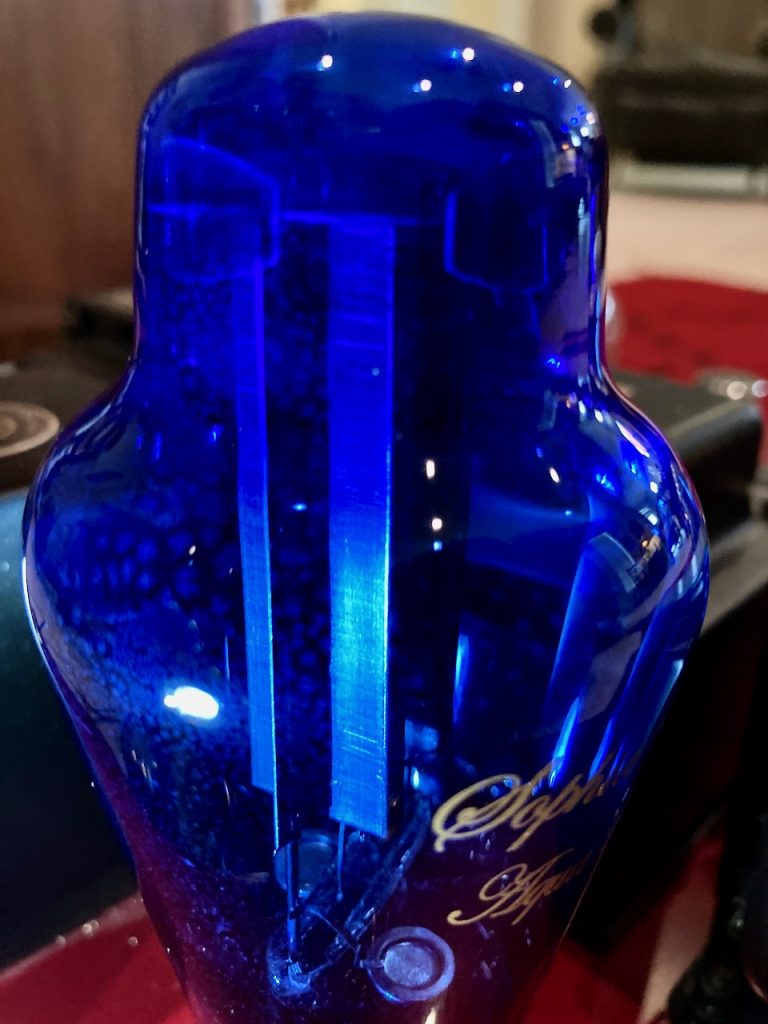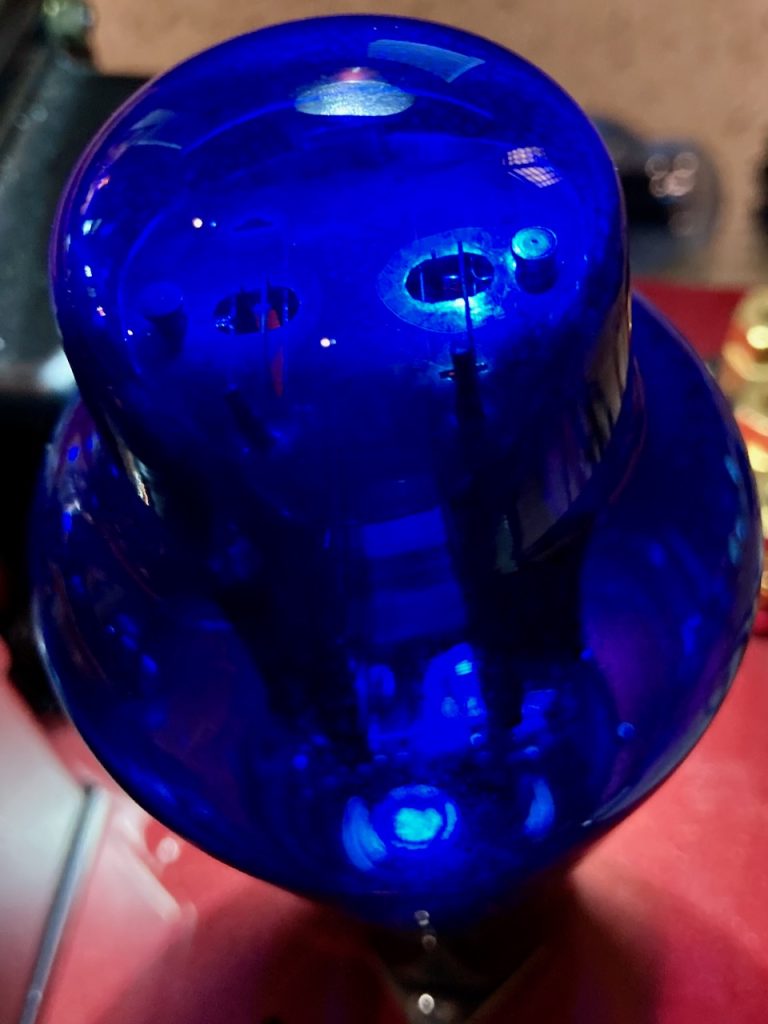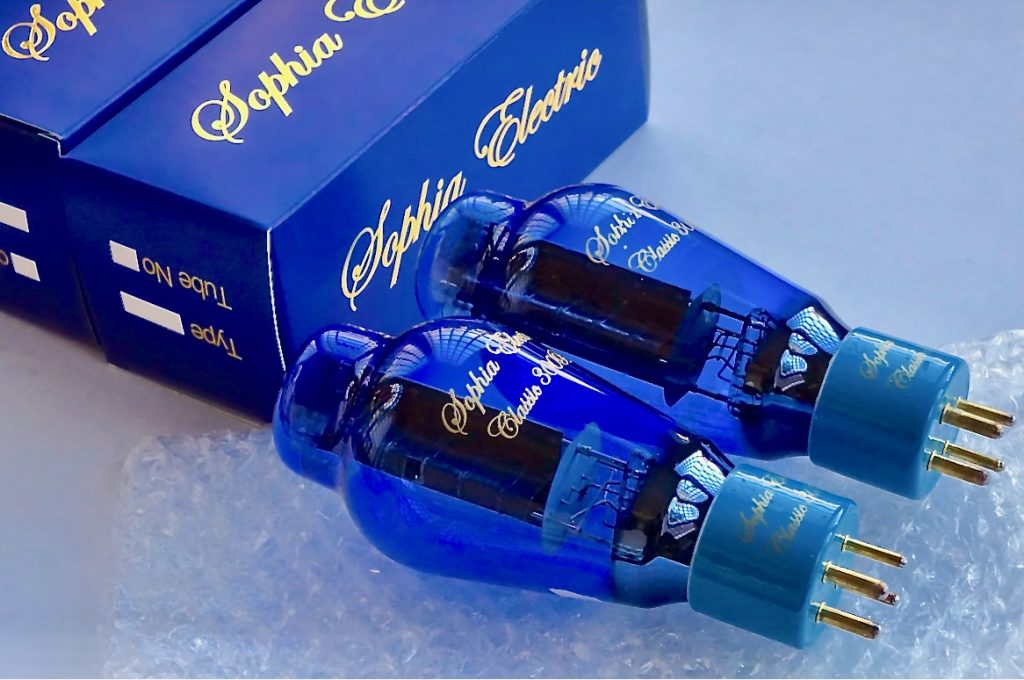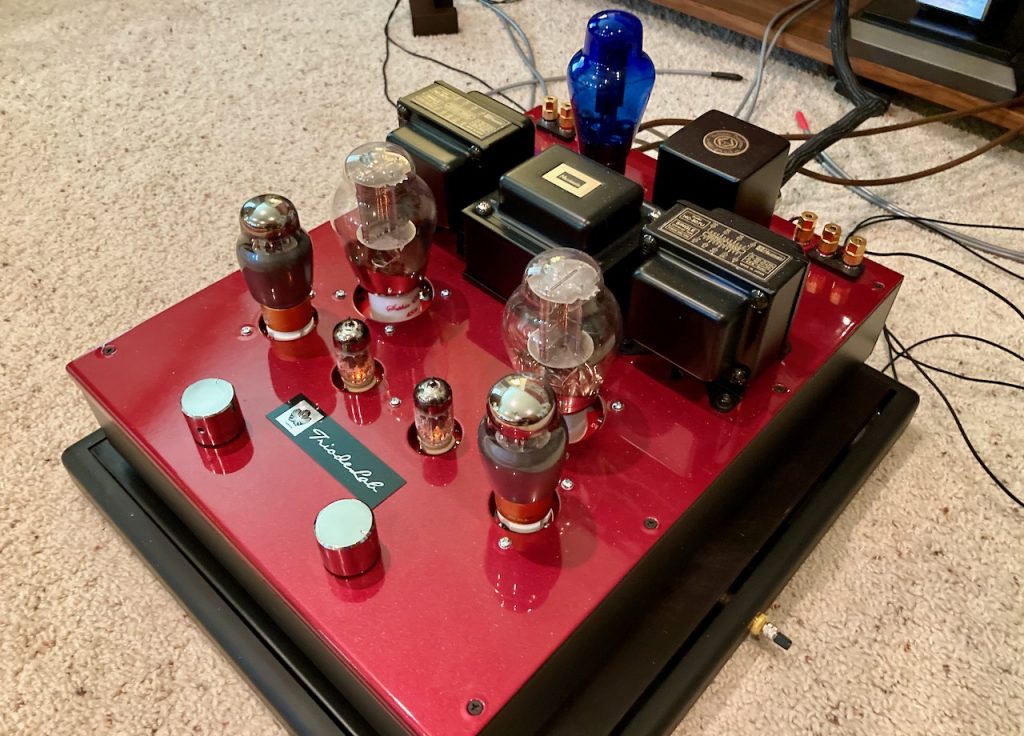As soon as I put Richard's new Aqua II 274B rectifier in the Triode Lab EVO 45 SET amp I knew something special was going on.
Fresh out the box the Aqua II 274B sounded gorgeous: beautifully natural tone, a huge sense of recorded acoustic, gorgeous tone color, a vivid sense of imaging presence, and excellent dynamics.
It's always fascinating and illuminating to hear what Richard has to say about the designs of his vacuum tubes, so I asked Richard if he would tell us about the design of his new Aqua II 274B rectifier, and here's what he had to say:
"The latest Sophia Electric design and production of this premium 274B rectifier tube was originally planned for Sophia Electric’s 20 Year Anniversary in 2021, but due to the Covid-19 pandemic, this product was delayed."
"Thus, we elected to rename it as the Aqua II version of the popular original Aqua blue glass 274B rectifier tube."
"The Aqua II 274B features a number of technical innovations:"
"The first innovation is that the Aqua II has a higher current output (max 220ma) compared to the original Aqua 274B (max 180ma), and way more compared to the WE 274B (max 150ma)."
"Secondly, the Aqua II has a lower impedance than any other 274B ever made, thus higher efficiency in converting AC into DC."
"Higher dissipation power rating with visibly bigger and heavier internal construction."
"New generation of spark arc suppression technology to eliminate arc possibility (WE274B is the internal spark arc king)."
"What does Aqua II 274B sound like?"
"First, we describe it as far more musical than any other 274B or 5U4G tubes ever made. It has a higher resolution – akin to watching 8K video instead of 1080 – and even more live-performance-like sound. Every musical instrument and voicing are more clear-cut from the rest of the orchestra."
"The Aqua II gives you the feeling that you've just upgraded your amp / preamp with a boatload of Black Gate capacitors. With Aqua II 274B the type of performance improvement one desires from Black Gate capacitor upgrade is fulfilled."
"A brief history of 274B tubes."
"Western Electric was the first company to make 274 tubes. The 274 rectifier launched in the 1930s to complement its WE 300B tubes in the WE 91 amplifiers that were used in movie theater cinemas across the USA."
"The Western Electric Model 274A has a 4-pin 300B-like tube socket while the Model 274B would fit into octal socket designed for 5U4G. Other than the tube socket difference, the rest is the same."
"Note: octal tube socket is the most commonly seen standardized socket in the later years. The 6SN7 or 6L6/EL34/KT88 tube socket of later years also utilize an octal tube socket."
"Compared to the industry standard rectifier tube, namely RCA 5U4G tube, the 274B offers much lower power supply impedance; thus it has a better resolution and high frequency extension. Given such a big sonic advantage of 274B over RCA’s 5U4G, it begs the question of why the WE 274B did not get used more in other amps and preamps?"
"What was the limitation?"
"The WE 274B requires that the power supply's first capacitor’s capacitance value to be 4uf or smaller, otherwise it would trigger a big electrical flash spark. Sometimes it may even blow out the fuse."
"When most equipment in the marketplace was designed for the 5U4G rectifier that permitted 47uf of capacitance, it became impossible to directly replace a 5U4G with a WE 274B without power supply modifications."
"For this strict requirement reason, the WE 274B did not get any significant market. As a result the RCA 5U4 tubes had the dominant market share."
"Fast forward to the era of the mid-1980s when Japanese currency has appreciated significantly over time. Powered by their new purchasing power, the Japanese audiophiles re-discovered and bid on vintage American vacuum tubes and tube electronics."
"Two of the most well-known and sought after items were the Western Electric 300B tube and 274B tubes."
"By the time American audiophiles got into high end tube audio in the mid-1990s, the WE 274B and WE 300B tubes were commanding stratospherically high prices."
"In 2023, a single vintage WE 274B untested tube may be listed for $4999.99 in an auction. That is an incredibly high price for a 274B rectifier."
"Sophia Electric’s proudest milestones since 2001:"
"In 2001, Sophia Electric debuted the Princess 274B rigid plate rectifier to fulfill the gap left by the WE 274B."
"In 2002, Sophia Electric introduced a mesh plate design of 274B (above). As much as we love the mesh plate 274B tube, the requirement of low capacitance of 10uf or lower at the first capacitor limited its potential use."
"In 2016, Sophia Electric released the revolutionary blue glass Aqua 274B that lifted the capacitance limitation (above), broadening the 274B market to be almost fully interchangeable with a 5U4G."
"This MK II version of Aqua 274B tube is the ultimate 274B from Sophia Electric. It delivers an unforgettable magical sound that is the trademark of Sophia Electric vacuum tube house sound.
Along with Aqua II 274B tube, a new Classic II 300B tube was also debuted (photo below)."
Many thanks to Richard for his discussion of the design of his new Sophia Electric Aqua II 274B rectifier.
For additional information you can read my The Art of Vacuum Tubes: Sophia Electric 45 Mesh Plate Triodes and Aqua 274B Rectifier article at Positive Feedback.
The Sophia Electric 45 mesh plate and Aqua 274B rectifier tube set described in the Positive Feedback article I've been running in the Triode Lab 45 SET EVO integrated amplifier since it arrived here in November of 2020.
As an aside, Richard didn't mention the reason for the blue glass in this description, but he did in the linked article, so let me repeat that for you:
One of the first things you'll notice when you look at Sophia Electric Aqua 274B rectifier is its blue-tinted glass bulb. I asked Richard if he would tell us about the reason for that blue tint.
"The blue tint that we've added to the glass not only looks exotic, but during the voicing process we found that the blue tint of the ST shaped enclosure added more sonic impact to the presentation of the music.
"Vintage US military tubes often had a black metal base and/or black-grayish smoky carbon-containing paint sprayed on the inside of the glass tubes for light shielding to reduce noise. British and German military tubes often used red paint for light shielding to reduce noise.
"We have auditioned various light shielding possibilities, and ultimately settled on the blue tinted glass, which when combined with ST bottle shape, provided additional musicality and a distinctly better tone.
"Back when all vacuum tubes were placed inside a chassis, there was no need for consideration about light induced noise. However, high-performance audio enthusiasts now like to see the tubes displayed in the open, so they can see them from their listening seats, and they also enjoy seeing the glow of the filaments.
"The blue tint ST bottle shape is an ideal solution, as it is a beautiful and excellent sounding bottle shape, and the blue tint offers the benefit of a reduction in light induced noise, while still allowing the listener to see the beautiful glow of the filaments."
The blue tinting of the new Aqua II 274B is even deeper than that of the original Aqua 274B, for even better light shielding. It makes a difference, giving a darker and quieter background that allows me to hear deeper into recordings. I can't see the internals light up quite as much in the Aqua II compared to the original, but I'll take the better sound quality any day.
I've been impressed by how good the new Aqua II 274B is sounding in place of the original, even with only a couple hours of listening time on it. It's definitely better, and that's saying something, as the original Aqua 274B was a stonking good tube, as you can read about in the linked article.
Right now I'm listening to a live Jim Hall performance that was a transfer from a master tape that the bass player gave to friend David Gitlen who was at the recording session. It's one of those amazing performances that insiders pass around to each other, ooh and ahh over, but you can't buy it (as far as I know).
I'm listening to the Jim Hall master tape transfer through the vacuum tube Audio Note (UK) CD 5.1x CD player that I'm in the process of writing the review for now, and it is freaky good.
I need to get David over here to listen to it. David has the best ears of anyone I've ever met for hearing what is going on in the music and the recordings, and I think he'd really dig it.
With the new Aqua II 274B providing the juice to the Triode Lab EVO 45 SET, it sounds bloody amazing. So much resolution of subtle overtones, so much nuance and "touch" on the instrument by Jim, so much body of the guitar, so much naturalness. Warm, rich, natural, colorful, nuanced, and beautiful.
I'll be doing some listening comparisons with the new Aqua II 274B and comparing it to the original Aqua 274B after I'm sure the Aqua II 274B is fully run-in.
Really though, this is a no-brainer, the new Aqua II 274B sounds fantastic, and if you can I suggest you lay up a few to carry you through the ups & downs of the vacuum tube market as it is in 2023. If we get another covid blast this Fall and Winter you'll be glad you've got a few spares.
Now its time to relax this evening and enjoy the music!
Postscript: Friend David Gitlen came by for a listening session yesterday. It's always a pleasure to catch up with David and do a little music listening. David is a life-long musician, a jazz guitarist. Not only is David a phenomenally good jazz guitarist who has rubbed shoulders with greats like Jim Hall and Joe Pass, David never ceases to amaze me at what he can hear in musical performances, as well as the recording & audio arts.
David has the best 'ears' for hearing what is going on in the music, the recordings, and audio kit of anyone I've ever met.
David appreciates fine audio, but he's more into playing music than just listening to it as hobby like those of us in the audiophile crowd. As such, his comments about audio are particularly relevant, as there's none of of the usual audiophile baggage in play, just insightful and illuminating comments about music, and the recording & audio performance.
David really likes the combination of the Audio Note (UK) CD 5.1x CD player, the Triode Lab EVO 45 SET integrated amp, and the Tannoy Westminster Royal SE loudspeakers that we were listening to (below).
It's a combination of audio equipment that sounds 'real' musically and gets the music right in terms of the feelings of emotional engagement you get with live music.
We spent some time listening to the Jim Hall transfers from a master tape that I mentioned in my above comments about the Sophia Electric Aqua II 274B rectifier. There's 3 full CDs worth of performances of Jim Hall playing, and the recordings are superb (magnetic era stereo tape), and it puts Jim right in the room with the listener. It's as close as you are going to get to sitting in on a live performance of Jim Hall from the 1970s.
David spotted the new Aqua II 274B rectifier. "So that's the new blue tube?" We were enjoying listening to Jim Hall, oohing and aahing about Jim's incredible playing. David is very familiar with the performance of the 45 EVO with the original Aqua 274B, so he noticed the differences between the Aqua and the Aqua II right away.
David commented on the great tonal realism, the improved resolution of nuance, and most importantly the superb musicality.
"It sounds like Jim is right here with us." Jim was playing his Gibson ES-175 in these recordings, and the natural tone and timbre of the ES-175 came through in breathtaking realism.
David is a lucky man, as he's had a lot of great times listening to Jim play over the years, and even playing with Jim at times. He knows what Jim's playing sounds like by heart, and of course, exactly what his guitars sound like.
David noticed something right away with the Aqua II 274B that I missed completely. "Notice how much better you can hear everything in the music even at lower volumes?" We were listening at levels in the low to mid 70-80s dB.
David was exactly right. Jim tends to play softly, but the Aqua II made everything much more intelligible and musical at the lower volumes Jim plays at, just like in real life.
David was telling me about how Jim used to like to say that he "let the amplifier do the work" when playing jazz. What Jim was getting at was that he had a very soft and articulate touch on the instrument, achieving beautiful tone with his 'soft touch' technique, but with the amp helping to give adequate volume for a performance.
But there's more to it than that ...
David was telling me a story about one of Jim's other students, where he was teaching him how to project the music while playing with a softer touch and lower volumes. Jim would go in another room, and tell the student to play softly, but to project so that Jim could hear all the student was doing from the other room.
Jim would demonstrate this technique in live performances as well. He would be on stage with his Gibson ES-175 plugged into the amp, and of course the sound reenforcement people had mics on the amp and guitar as is customary. Jim would have them turn off the mics one by one as he continued to play - softly - and yet his incredible tone and playing still projected into the audience. Its rather uncanny.
I know, it all sounds rather counterintuitive, but it was a real trait of Jim Hall's jazz guitar playing, and we could really hear the Aqua II 274B bring that particular trait of Jim's playing to life. Jim was here with us, playing softly, but so vividly present and natural sounding, and so emotionally evocative.
It's like Richard said about the high-resolution of the Aqua II, and which David confirmed: you can just hear a lot more nuance in the music, and that also means at lower listening levels you don't get a sense you're missing anything from the music. The music just projects better to the listener.
It's all there, strikingly so, even at lower volumes. And that high-resolution doesn't come at the expense of natural tonality, or with an annoying exaggeration in the presence or brilliance regions of the audio spectrum that a lot of newly minted audiophiles listen for.
Rather it's more of a musicians balance of real sound, real music, and natural tonality, to reproduce incredible musical performances from recordings.
For audiophiles I should mention that the aural images also had more body and presence, and a more flesh & blood live music feel to it. The visuospatial cues of magnetic era stereo recordings become more obvious and more naturally 'live' sounding at the same time.
Those traits also allowed me to hear more deeply into the recording methods used into the different eras of the recording arts whether I was listening to acoustic, electric, or magnetic era recordings, or even with regards to recording engineers' style within in the same recording eras.
Much more to come on the Aqua II 274B as I get some more time in on it.
As always, thanks for stopping by, and may the tone be with you!









































